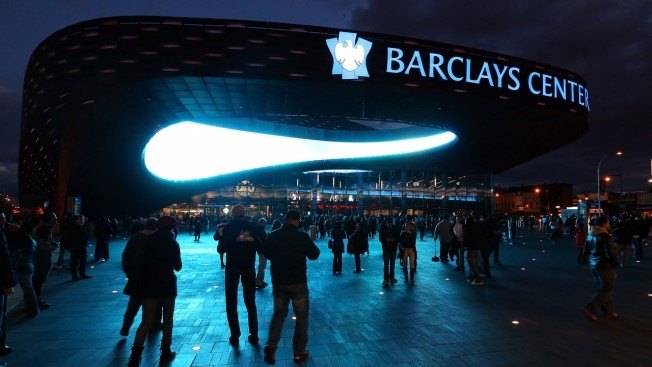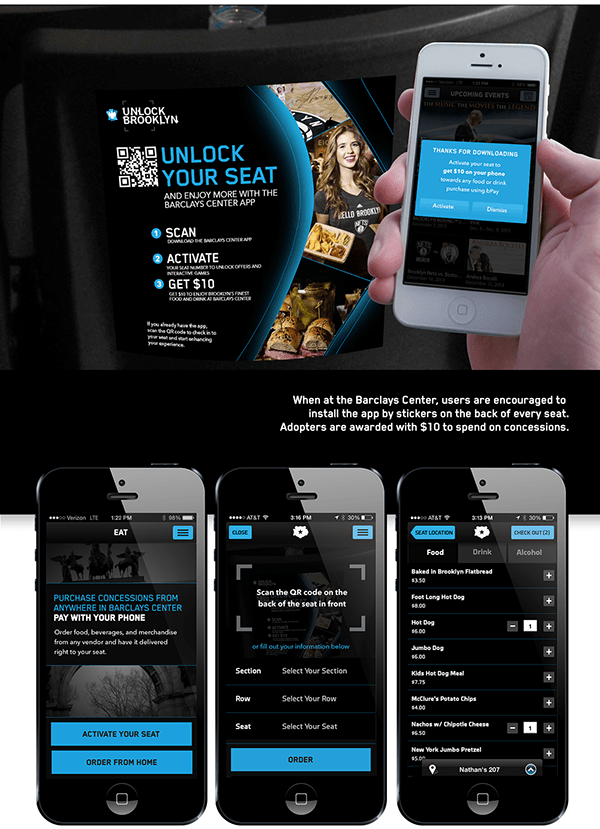Are Smart Stadiums the Future of Live Sports?

Technological advances in sports broadcasting and home entertainment systems have enhanced the at home viewing experience to the point where many fans think it’s better than actually being at the game. A few stadiums in the US have decided to embrace the digital revolution in an effort to create a better fan experience and Barclays Center in Brooklyn, NY is one of those stadiums.
Pretend that you’re back in the year 1998. What’s the difference between watching an NBA game on your couch at home versus in the stadium? You might answer that you’re closer to the action at the stadium, or that everything is so much bigger, clearer, and more exciting when you’re at the game. Now let’s come back to the present day. Is your answer the same?
Technological advances in sports broadcasting and home entertainment systems have enhanced the at home viewing experience to the point where many fans think it’s better than actually being at the game. In 1998, 54% of sports fans said that they would rather be at a game than in their living room, but by 2011 that number dropped to 29% 1. This has created a huge problem for sports arenas around the world as they struggle to stay relevant in the digital age. A few stadiums in the US have decided to embrace the digital revolution in an effort to create a better fan experience and Barclays Center in Brooklyn, NY is one of those stadiums.
Source: How Barclays Center Uses Technology to Keep the Modern Fan Experience Current
Barclays Center opened in September 2012 and is the home to the NBA’s Brooklyn Nets. The Stadium is owned by Brooklyn Arena Local Development Corporation and operated by AEG Live. It was designed to take advantage of the most innovative digital technology in hopes of allowing fans to experience the some of the comforts of their home at the stadium. Barclays operates using Cisco StadiumVision and Cisco Connected Stadium Wi-Fi to make every fan feel at home. Although most millennials in the US think Wi-Fi access is a give, the idea of having reliable Wi-Fi access in high density areas like sporting arena’s is actually a relatively new concept. The infrastructure required to provide reliable cellphone service and Wi-Fi in a high-density area like a stadium is quite extensive and costly, but Barclays Cetner believes it is essential to the fan’s experience at their venue. Not only does every fan have access to Wi-Fi at the Barclays Center, but with the Barclays Center app, fans can truly bring their home viewing experience to the stadium. Eight cameras capture every angle of the game courtside, and fans can view all available replays and angles from their mobile device while watching the game. Fans can even order concessions from the phone and are informed when their items are ready for pickup. And if Fans don’t like their seats, they can upgrade instantaneously through the app and seat prices are constantly updating based on demand. All this connectivity is also an operational advantage for the Barclays Center. Information displayed on any screen in the stadium can be updated remotely so Barclays Center can display changes in concession prices, promotions, or updated transportation information. Advertisers can change the content of their ads remotely without ever having to contact a Barclays Center representative, which saves money and time on game day. Increased connectivity also allows Barclays Center to collect much more sophisticated consumer data, which will help with future customer segmentation and targeting.
Source: Barclays Center App
So why isn’t Barclays Center a huge success? Studies show that only 20-25% of fans at Brooklyn Nets games access the Wi-Fi network while attending games2. Even though all of this new technology exists, it appears that stadium operators don’t yet understand exactly how to deploy it in a way that will convince fans to come back to the stadium. Stadium operators need to understand exactly what aspects of the home viewing experience fans are missing at stadiums, or maybe stadiums shouldn’t be striving to match the home viewing experience, but should be trying to leap frog home viewing by creating an entirely new experience. Maybe a more interactive take on technology will enhance a fan’s experience. One example of a more interactive solution is the deployment of google glass by the Sacramento Kings. Fans at the game could actually view the action from the point of view of a player or cheerleader by connected to that athlete’s google glass from their seat3. The Dallas Cowboys send push notifications to their fans at specific times during the game. These notifications tell fans to hit a button on their phone which triggers their phone camera to flash and vibrate. When the whole crowd does this together it creates a stadium wide wave3. Although this seems like a simple example, it is a step toward a more interactive solution. Barclays Center needs to focus making the stadium experience something that fans cannot get at home, and using technology to allow players and fans to interact with each other is definitely something that would differentiate the stadium experience. [Word Count 774]
1 “Will Big Data Get Fans Off the Couch and Into the Stadium?” Northwestern University School of Professional Studies. N.p., n.d. Web. 15 Nov. 2016.
2 Kapustka, Paul. “NBA Stadium Tech Research – ExteNet Systems.” Mobile Sports Report, 2014. Web. 15 Nov. 2016.
3 @umbel. “10 Ways Stadiums & Venues Are Using Technology to Delight Fans & Keep Them Coming Back.” Umbel. N.p., 29 Sept. 2015. Web. 17 Nov. 2016.
4 Cisco. “Digital Transformation with the Internet of Everything.” Www.cisco.com. Cisco, n.d. Web. 15 Nov. 2016.
5 “How Barclays Center Uses Technology to Keep the Modern Fan Experience Current.” AdWeek. N.p., 22 Oct. 2015. Web. 17 Nov. 2016.
6 @Tshaoymears. “Barclays Center App.” Behance. N.p., n.d. Web. 17 Nov. 2016.





I agree with you that, in order to be successful, Barclays must be able to offer a unique experience instead of trying to match or compete with the at-home experience. The Barclays Center can learn from Levi Stadium, home of the San Francisco 49ers, which has seen success with a similar app. For example, your post notes that the Barclays app notifies you when pre-ordered food is ready for pick-up, but the Levi’s Stadium app actually takes it a step further to deliver food to your seat. While the options are still somewhat limited, the Levi’s app understands that the optimal experience for fans will not draw them away from watching the game or concert. Another feature offered by the Levi’s app is personalization, which human greeters and digital signs use to welcome individuals into the stadium [1]. This last piece reminded me of Disney MagicBands, which combine ticketing, payment, and keys into a single piece of wearable tech. It can track their preferences and personalize the experience [2]. Perhaps Barclays could offer a similar band to each fan who purchases season tickets, to wear each time they attend a game, using it for ticketing and purchases. It would also help Barclays collect significant data on individuals and the friction-free experience encourages more spending throughout the game (which Disney has seen).
[1] http://sportsbusiness.today/6-key-stadium-technlogy-learnings-from-the-49ers-and-levis-stadium/
[2] https://www.wired.com/2015/03/disney-magicband/
I definitely agree that Barclays Center should try and use their technological infrastructure advantage to differentiate the in stadium experience from the at home experience to make the stadium experience the fan’s preference. One area that I think they could also differentiate themselves is between the other competing sports arenas. Barclays clearly has an advantage over neighboring stadiums with their wifi infrastructure and the ability to order food for pick up without waiting in line. New York City has a large market of casual sports fans that Barclays should try and leverage to bring in fans for the unique, high-tech experience they won’t find elsewhere.
This is a well researched and topical piece, MC2018. I agree that the advent of HD TVs offers better a better viewing experience than actually attending the game. Integrating stadiums with technology is definitely one way to improve the live experience and bring back fans. However, I think that several other factors have a larger impact on attendance, including team record, comfort, and parking. For instance, the San Francicso 49ers built a new stadium in Santa Clara in 2014 and lauded it as the most technologically advanced stadium ever. However, fans have been turned off by the stadium due to high prices, intense heat, terrible parking, and a sterile atmosphere due to the “distractions” caused by some of the new technology. Maybe a better way to lure back fans is to use technology to reduce costs and time for fans by offering optimized routes and dynamic pricing. For more information on some of these factors, please see the following two articles:
http://www.nbcbayarea.com/news/local/49ers-Unveil-Plan-to-Improve-Levis-Stadium-Experience-322107082.html
http://www.santacruzsentinel.com/article/NE/20141231/NEWS/141239925
Thanks for posting. I agree that stadiums such as the Barclays Center need to focus on revolutionizing the experience they provide, but shouldn’t be attempting to do so by replicating the home viewing experience. The following article https://www.eventbrite.com/blog/ds00-5-reasons-people-go-to-sporting-events-and-what-we-can-learn-from-them/ provides 5 reasons people go to sports: socializing and networking, halftime shows, promotions and giveaways, team spirit, and impressing someone. You will see that none of the reasons have anything to do with feeling at home. I would argue that although people want to be comfortable they are going to games to get away from home and want a truly unique experience. Barclays Center should be attempting to use technology to provide customers with something they are unable to get at home. I found another interesting article http://jameystegmaier.com/2012/04/why-do-you-go-to-live-sporting-events/ that suggests that sports teams could improve attendance by helping their fans remember the experience by offering some type of special ‘you were there’ digital memento.